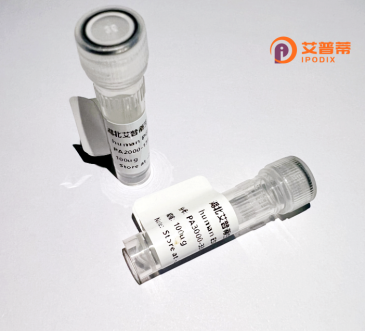
| 纯度 | >90%SDS-PAGE. |
| 种属 | Human |
| 靶点 | PGBD3 |
| Uniprot No | Q8N328 |
| 内毒素 | < 0.01EU/μg |
| 表达宿主 | E.coli |
| 表达区间 | 1-593 aa |
| 活性数据 | MPRTLSLHEI TDLLETDDSI EASAIVIQPP ENATAPVSDE ESGDEEGGTI NNLPGSLLHT AAYLIQDGSD AESDSDDPSY APKDDSPDEV PSTFTVQQPP PSRRRKMTKI LCKWKKADLT VQPVAGRVTA PPNDFFTVMR TPTEILELFL DDEVIELIVK YSNLYACSKG VHLGLTSSEF KCFLGIIFLS GYVSVPRRRM FWEQRTDVHN VLVSAAMRRD RFETIFSNLH VADNANLDPV DKFSKLRPLI SKLNERCMKF VPNETYFSFD EFMVPYFGRH GCKQFIRGKP IRFGYKFWCG ATCLGYICWF QPYQGKNPNT KHEEYGVGAS LVLQFSEALT EAHPGQYHFV FNNFFTSIAL LDKLSSMGHQ ATGTVRKDHI DRVPLESDVA LKKKERGTFD YRIDGKGNIV CRWNDNSVVT VASSGAGIHP LCLVSRYSQK LKKKIQVQQP NMIKVYNQFM GGVDRADENI DKYRASIRGK KWYSSPLLFC FELVLQNAWQ LHKTYDEKPV DFLEFRRRVV CHYLETHGHP PEPGQKGRPQ KRNIDSRYDG INHVIVKQGK QTRCAECHKN TTFRCEKCDV ALHVKCSVEY HTE |
| 分子量 | 67.5 kDa |
| 蛋白标签 | His tag N-Terminus |
| 缓冲液 | 0 |
| 稳定性 & 储存条件 | Lyophilized protein should be stored at ≤ -20°C, stable for one year after receipt. Reconstituted protein solution can be stored at 2-8°C for 2-7 days. Aliquots of reconstituted samples are stable at ≤ -20°C for 3 months. |
| 复溶 | Always centrifuge tubes before opening.Do not mix by vortex or pipetting. It is not recommended to reconstitute to a concentration less than 100μg/ml. Dissolve the lyophilized protein in distilled water. Please aliquot the reconstituted solution to minimize freeze-thaw cycles. |
以下是关于重组人PGBD3蛋白的3篇参考文献的简要总结:
---
1. **文献名称**:*PGBD3 promotes site-specific oncogenic mutations in human tumors*
**作者**:Sokolowska et al.
**摘要**:本研究揭示了重组人PGBD3蛋白具有转座酶活性,能够在基因组特定位点(如CCDC66基因)介导DNA断裂和重排,与多种癌症(如肺癌、卵巢癌)的突变相关。
2. **文献名称**:*PGBD3 is a component of the oncogenic rearrangement landscape in childhood cancers*
**作者**:Henssen et al.
**摘要**:通过表达重组PGBD3蛋白,发现其通过转座酶样活性诱发神经母细胞瘤等儿童肿瘤中的染色体异常重排,揭示了其在驱动致癌基因组不稳定性中的作用。
3. **文献名称**:*Biochemical characterization of human PGBD3 reveals a catalytically active transposase homolog*
**作者**:Wicker et al.
**摘要**:对重组表达的PGBD3蛋白进行生化分析,证实其保留了类似PiggyBac转座酶的催化活性,并依赖特定的DNA基序(如“CTG”序列)发挥功能。
---
**注**:PGBD3是PiggyBac转座酶衍生蛋白家族成员,主要研究集中在基因重组机制与癌症关联。以上文献均围绕其重组表达的蛋白活性及其在疾病中的作用展开。
Recombinant human PGBD3 (PiggyBac Transposable Element Derived 3) protein is a genetically engineered variant of the human PGBD3 enzyme, a member of the piggyBac transposase-derived protein family. PGBD3 retains structural homology to piggyBac transposases, featuring a conserved catalytic domain with a putative DDE triad (aspartate, aspartate, glutamate) critical for DNA cleavage and transposition activity. However, in humans, PGBD3 has lost intrinsic transposase functionality due to evolutionary domestication, likely repurposed for host cellular functions. Studies suggest its involvement in genomic instability and chromatin remodeling, potentially linked to DNA repair processes, transcriptional regulation, or somatic genome rearrangements in specific contexts, such as cancer. Recombinant PGBD3 is typically expressed in heterologous systems (e.g., E. coli, mammalian cells) with purification tags (e.g., His-tag) for experimental use. Researchers utilize it to investigate its residual enzymatic activity, DNA-binding properties, and interactions with host proteins, aiming to unravel its role in physiological and pathological pathways. Its study may provide insights into transposon-derived proteins' contributions to genome evolution and diseases like leukemia or neurodevelopmental disorders. Current research remains exploratory, focusing on mechanistic details and potential therapeutic targets.
×